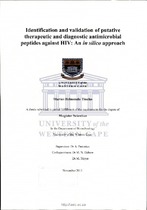| dc.description.abstract | Background: Despite the effort of scientific research on HIV therapies and to reduce the rate
of HIV infection, AIDS remains one of the major causes of death in the world and mostly
in sub-Saharan Africa. To date, neither a cure nor an HIV vaccine had been found and the
disease can only be managed by using High Active Antiretroviral Therapy (HAART) if
detected early. The need for an effective early diagnostic and non-toxic treatment
has brought about the necessity for the discovery of additional HIV diagnostic methods and
treatment regimens to lower mortality rates. Antimicrobial Peptides (AMPs) are components
of the first line of defense of prokaryotes and eukaryotes and have been proven to be
promising therapeutic agents against HIV.
Methods: With the utility of computational biology, this work proposes the use of profile
search methods combined with structural modeling to identify putative AMPs with
diagnostic and anti-HIV activity. Firstly, experimentally validated anti-HIV AMPs were
retrieved from various publicly available AMP databases, APD, CAMP, Bactibase and
UniProtKB and classified according to super-families. Hidden Markov Model (HMMER) and
Gap Local Alignment of Motifs (GLAM2) profiles were built for each super-family of anti-
HIV AMPs. Putative anti-HIV AMPs were identified after scanning genome sequence
databases using the trained models, retrieved AMPs, and ranked based on their E-values. The
3-D structures of the 10 peptides that were ranked highest were predicted using 1-TASSER.
These peptides were docked against various HIV proteins using PatchDock and putative
AMPs showing the highest affinity and having the correct orientation to the HIV -1 proteins
gp120 and p24 were selected for future work to establish their function in HIV therapy
and diagnosis.
Results: The results of the in silica analysis showed that the constructed models using the
HMMER algorithm had better performances compare to that of the models built by the
GLAM2 algorithm. Furthermore, the former tool has a better statistical and probability
explanation compared to the latter tool. Thus only the HMMER scanning results were
considered for further study. Out of 1059 species scanned by the HMMER models, 30
putative anti-HIV AMPs were identified from genome scans with the family-specific profile
models after the elimination of duplicate peptides. Docking analysis of putative AMPs against
HIV proteins showed that from the 10 best performing anti-HIV AMPs with the highest E-scores,
molecules 1,3, 8, and 10 firmly bind the gp120 binding pocket at the VIN2 domain
and the point of interaction between gp120 and T cells, with the 1st and 3rd highest scoring
anti-HIV AMPs having the highest binding affinities. However, all 10 putative anti-HIV
AMPs bind to the N-terminal domain of p24 with large surface interaction, rather than the C-terminal.
Conclusion: The in silica approach has made it possible to construct computational models
having high performances, and which enabled the identification of putative anti-HIV peptides
from genome sequence scans. The in silica validation of these putative peptides through
docking studies has shown that some of these AMPs may be involved in HIV/AIDS
therapeutics and diagnostics. The molecular validation of these findings will be the way
forward for the development of an early diagnostic tool and as a consequence initiate early
treatment. This will prevent the invasion of the immune system by blocking the VIN2
domain and thus designing of a successful vaccine with broad neutralizing activity against
this domain. | en_US |

